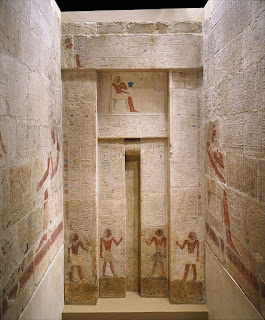Mastaba Tomb of Perneb
Old Kingdom
Late in Dynasty 5, the palace administrator Perneb built a tomb at Saqqara, twenty miles south of Giza. The tomb included an underground burial chamber and a limestone building called a mastaba. This contained a decorated offering chapel and a statue chamber, usually called a serdab. The mastaba facade and chapel were purchased from the Egyptian government in 1913 and, together with a replica of the statue chamber, were reconstructed at the entrance to the Museum's Egyptian galleries. Inside the chapel, the painted reliefs depict Perneb seated before an offering table receiving food and other goods from relatives and retainers. Actual offerings were placed on the slab set before the false door, through which Perneb's spirit could pass in order to receive sustenance.
Met Museum

















































